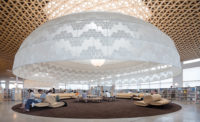Toyo Ito has been awarded the 2013 Pritzker Architecture Prize, announced Thomas J. Pritzker, Chairman of the Hyatt Foundation, which sponsors the award. The sixth Japanese architect to win the prize, Ito had been considered a leading candidate for years by outside observers. The 71-year old designer has made it his mission to “overcome Modernism” by freeing his buildings from that movement’s geometric, structural, and spatial conventions. In the process, he has created an extraordinary array of libraries, houses, shops, theaters, and other buildings distinguished by their maze-like arches, wavy columns, and other elements that defy the norm. Yet his works are so logical that they seem comfortable in their settings even as they startle us. Said Pritzker juror Yung Ho Chang, “Although Mr. Ito has built a great number of buildings in his career, in my view, he has been working on one project all along—to push the boundaries of architecture.”
Born in Seoul, Korea, but relocated to Japan as a small child, Ito lived in a house designed by the Marcel Breuer-trained architect, Yoshinobu Ashihara, during his high school years. This experience may have influenced his ultimate decision to pursue a career in design (at that time, he might have preferred to play baseball). Ito became serious about architecture while enrolled at the University of Tokyo. After graduating in 1965, he began working for Kiyonori Kikutake & Associates, where he remained until opening his own studio in 1971. “I learned from Mr. Kikutake how to create architecture for the body,” said Ito at his Toyko office. “In terms of design, I still use that direction today.”
One of his first works to capture the attention of critics was White U, a house he built for his sister in 1976. But the project that really catapulted Ito to international stardom and a steady stream of overseas commissions was Sendai Mediatheque, completed in 2001. As its ambiguous name suggests, the building combines various programmatic elements, such as library and gallery areas. Instead of dividing them with partitions, Ito modulated the interior loosely with 13 see-through columns that let functional zones connect fluidly. “This was a huge step away from modernism,” explains the designer. It also changed the notion of public architecture in Japan.
Among the building’s most distinctive visual features are the tubular columns themselves. Enclosing stairs and other usable spaces, they redefined the role of structure and its integration. Making a profound impact on legions of young Japanese architects, this theme emerged in many of Ito’s subsequent projects, such as the building for the Italian leather goods company, TOD’s, on Tokyo’s elegant Omotesando shopping street. Combining structure and skin, glass-and-concrete walls inspired by the leafy trees lining the boulevard enclose the building. As the walls ascend, their bough-like concrete elements bifurcate continually, yielding column-free space inside and a striking exterior that stands up to the other architect-designed flagship shops nearby.
While the expression of structure is rarely understated in Ito’s newer work, the architect maintains that structural materials have not changed fundamentally. Rather, it is the way he uses steel and concrete that has evolved. “Over the past 10 years, structural analysis has progressed, resulting in much more flexibility and innovation,” he explains. New fabrication methods have developed too: “The people working on-site have evolved alongside computer technology.” And these changes are enabling him to realize such spectacular buildings as the Taichung Metropolitan Opera House. Under construction in Taiwan, it will be an enormous, cavelike edifice containing multiple performance halls but nary a straight line anywhere (floor planes excepted) when it is completed in 2014. Even for Ito, buildings like this were until recently the stuff of fantasy.
Ito also has a strong sense of public responsibility. He speculates that one reason for this year’s prize is his commitment to the revitalization of the earthquake- and tsunami-ravaged Tohoku region. Shortly after the disaster, Ito teamed up with colleagues to launch the Home-for-All projects, a series of modest buildings that provide much-needed communal space for people living in temporary housing. For Ito, working with the survivors is not purely a social-welfare exercise. “A disaster zone, where everything is lost, offers the opportunity for us to take a fresh look, from the ground up, at what architecture really is,” he wrote in his book Toyo Ito – Forces of Nature (Princeton Architectural Press, 2012).
A number of the Home-for-All projects are being executed by younger designers under Ito’s aegis. “The works of many young architects are governed by an artistic way of designing, but these projects put things in perspective for them,” explains Ito. This is one way that Ito is passing on his knowledge and experience to the next generation. “He is a pioneer and encourages others to benefit from his discoveries and for them to advance in their own directions as well,” commented the Pritzker Jury. Indeed, a number of his former staff members, such as Kazuyo Sejima and Akihisa Hirata, have launched successful practices of their own. But his interest in education extends far beyond his employees and architecture students. This past year, Ito launched a weekend design school for 10- to 12-year-olds. “I am fascinated by their thinking,” Ito says, grinning broadly. In fact, he has designed a small, brick building for his youngest students that is currently under construction and will finish later this year.
Though Ito dreams of building more in Tohoku, he also is eager to work in the United States where he has yet to build. Sadly, his Berkeley Art Museum/Pacific Film Archive at the University of California was cancelled in 2009. But in a formal ceremony at the John F. Kennedy Library and Museum in Boston on May 29, Ito will leave his mark when he receives what has come to be known throughout the world as architecture’s highest honor.


































